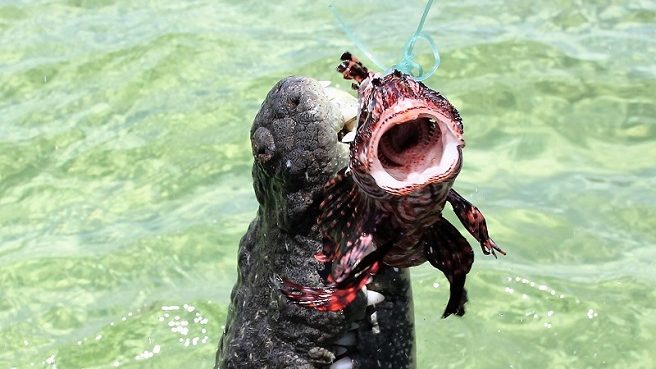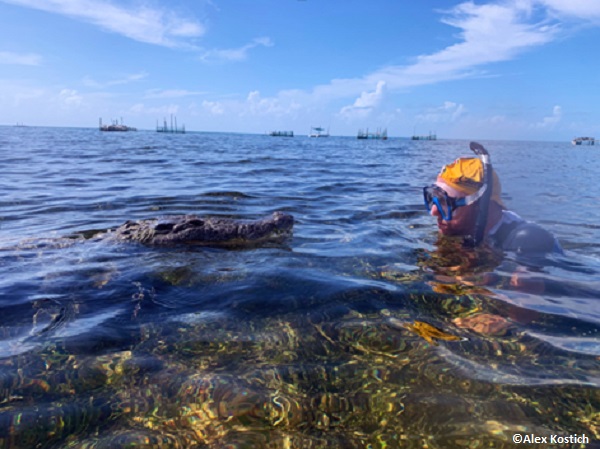Part 2 continues the journey with Christian Kemper in his quest to dive with crocodiles in Mexico.
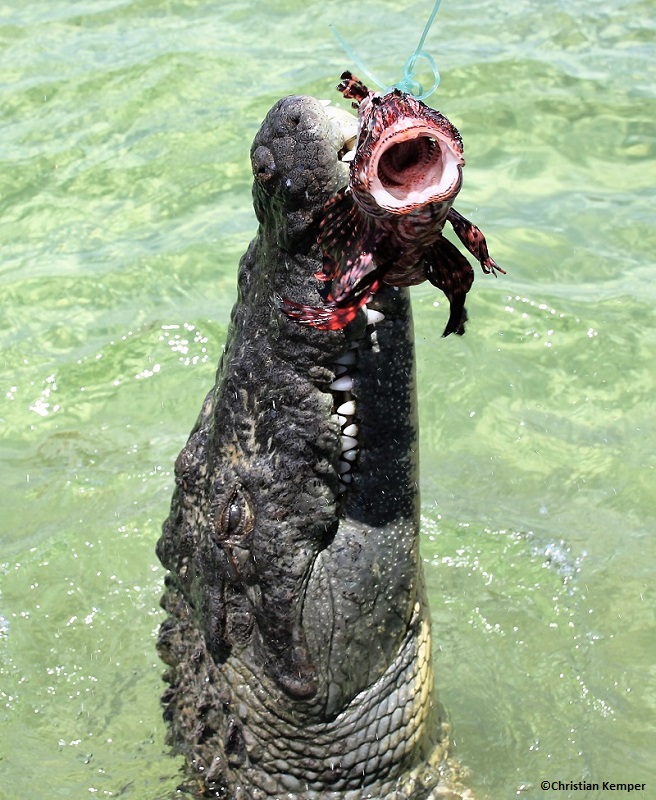
Banco Chinchorro is the largest atoll reef in the northern hemisphere, and is located off the extreme southeast coast of Mexico. This atoll covers a total area of 800 square kilometers (497 mi) and is 40 kilometers (25mi) long and 16 kilometers (10mi) wide, and thus larger than Cozumel. The three main islands, Cayo Lobos, Cayo Central and Cayo Norte, are only 6.7 km² large.
This healthy marine area was designated a biosphere reserve in 1996. Today, the atoll is uninhabited except for some stilt houses used by local fishermen. That’s where I want to go, because there are more than 300 crocodiles living in this nature reserve—318, to be exact.
At least that’s what the Rangers said who are stationed here. They also take care that illegal fishermen do not loot all the reefs.
To get there, Eli picks up me and five other divers at the airport.
There is Alex from Los Angeles. The 49-year-old was one of the best long-distance swimmers in the U.S. and has recently set a world record by swimming around Pitcairn Island. Also, on board is Greg from New York. His boat sank off Playa del Carmen while he was trying to dive with bull sharks. He had to spend hours in the ocean until he was finally rescued. All the while, he and the other divers were being circled by the sharks. Not a nice thought.
Mark comes from Queensland, Australia, and he has muscles as if he’s fighting with saltwater crocodiles every day at home.
Garin is actually an Englishman, but has been living in Bermuda for ten years, regularly taking part in spearfishing competitions for the notorious lionfish, which have spread like an epidemic and are eating all the coral fish, wiping out entire reefs. His experience will be important to us later. Because of its poisonous spines, predators such as sharks and groupers avoid these immigrants, thus, it has no natural enemies in the Caribbean.
Although many crocodiles live in Banco Chinchorro, they must first be lured in by us with these lionfish, which we have to spearfish every morning during a dive. So, we do something good for the ecosystem and at the same time we have prey for the crocs.
Then there’s Johnny, actually Jean Francois Dubios. Although his name suggests, he does not come from France but from Guatemala. He looks like a mix of D’Artagnan and Zorro. Of course, he has countless stories about women. And I’m there, the journalist from Germany. We all have extensive diving experience with sharks, but none of us has ever been in the water with wild crocodiles.
I want to know why it’s relatively safe to SCUBA dive with crocodiles in Banco Chinchorro, and in other places it would be pure suicide.
(By the way, the term “scuba diving” is incorrect, because we jump only with mask and snorkel into the ocean. A complete set of diving equipment would be inappropriate, since the water at the destination is only about 1.5 meter (5ft) deep. Using fins would stir up the sand, and visibility would be zero within seconds.)
Before we reach Banco Chinchorro, we have to drive from Cancun five hours south to the border of Belize. We drive past Playa del Carmen and Tulum. Then left into the bush.
Endless straight roads, then right and again endlessly straight, to a place called Xcalak. As Eli tells me, Xcalak was once to become the capital of the entire Quintana Roo region, but a hurricane destroyed everything. Now there is not much to see from the former glory: half-finished or abandoned houses and hotels line the streets. Not a place where I want to spend my holidays.
In addition, on the coast, the entire beach is meters thick with Sargasso grass. The brown algae carpet is certainly 20 meters wide (65ft), followed by a broth reminding only of water. But once you’ve done a short boat ride, there are great reefs and dive sites. On the last trip, Eli even saw manatees here.
The evening before our departure there is a dive briefing by Ernesto. The 42-year-old, originally from the Spanish island of Mallorca, has been leading the crocodile expeditions as a security diver for three years. He is an absolute cheerful person and always has a joke in stock. I guess you have to be that kind of guy if you face death day in, day out.
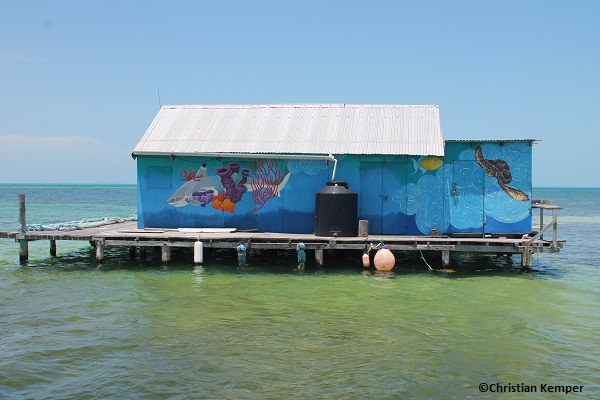
The mangrove island which we want is only two kilometers (1.2mi) long and 800 meters (.50mi) wide. In front of it, about 91 meters (.06mi) away, there are about a dozen fishermen’s huts on stilts in the ocean. Depending on the season, the locals catch lobsters or just fish. No showers, no beds, just a dump toilet for a total of ten people. This will be our home for the next three days!
Before we get there, we have to get through a two-hour boat ride the next morning, if all goes well. On the last expedition one week before, it took a full five hours!
To be on the safe side, we pull on neoprene tops with hoodies and stow our cameras and luggage in dry boxes. Our boat leaves at 9 o’clock and shortly after we have reached the open ocean, strong waves rock the boat. The spray whips us in the face and if we would not have the neoprene suits, we would be wet to the bone within seconds.
Once, the boat crashes down so hard after riding over a wave that it pulls me off the seat and I’m thrown onto Alex, who sits with his back turned toward me. If he got up now, I would hang on his shoulders like a backpack. I can hardly believe it, as Eli screams through the wind, “By the way, that’s the good weather!”
Luckily, I took two tablets against seasickness. But Eli was not wrong with the weather, because after 2 1/2 hours we reach the reef, where we want to spear the lionfish for the crocodiles. If the lionfish have no natural enemies, how come the crocodiles eat them? Are they immune to the poison? Eli explains, “No, but we cut off the long spikes before we feed them.”
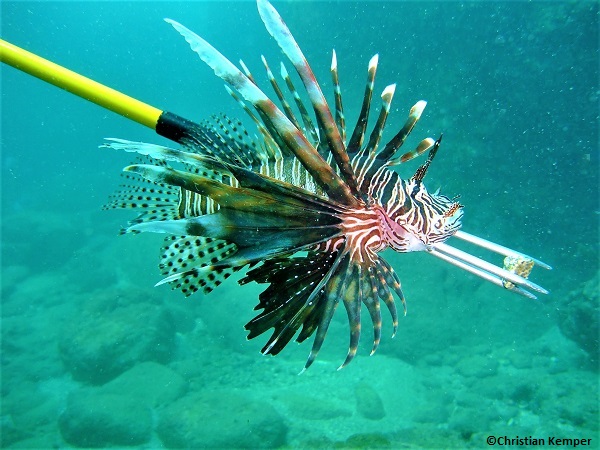
So, we jump into the water armed with harpoons and search the reef. But we are unlucky. At first, we do not find any lionfish and those we find and harpoon are immediately eaten by the nurse sharks, which are constantly buzzing around us. Somewhat disappointed, we finish the dive.
Eli reassures us there are enough lionfish from last week to attract the crocodiles. We continue for 20 minutes, throttle the engine and chug slowly into the mangrove area. Shortly thereafter, I spy the first crocodile! Excellent! It swims quietly next to our boat, as if it had expected us. I estimate it to be 2.4 meters (8ft) long. We hope it follows us and comes to the stilt houses, which we see shortly thereafter.
We have not quite laid out and unpacked, as Eli screams, are the crocs here already? No, about 30 meters (98ft) away, we see a large triangular fin that cuts through the water—a bull shark!
“I have never seen a bull shark here in six years,” says Eli.
Nice, but the thought of being in the water with crocodiles AND bull sharks at the same time, makes us feel queasy. Who ever thought this was something of a trip to the zoo and wouldn’t be coming home with all his body parts? Crocodiles and sharks are unpredictable—or are they? The warm water in which they are at home feels rather more like a cozy bath tub than bare danger. However, the green mangrove forests and the seagrass provide crocodiles with the ideal camouflage.
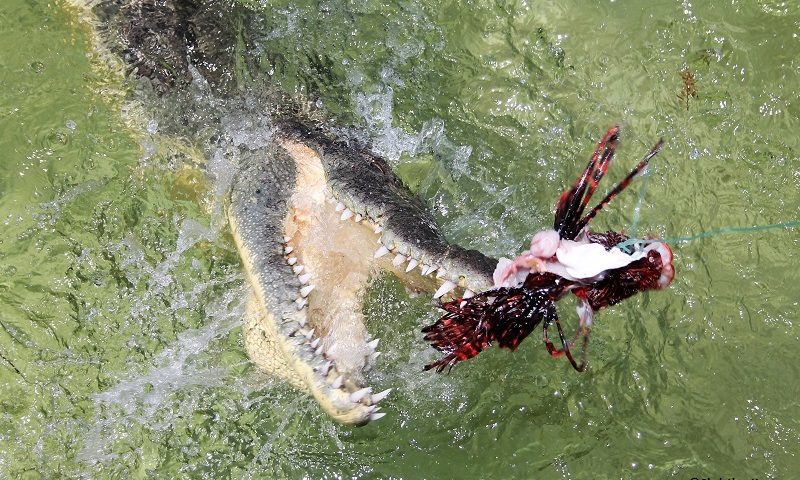
I do believe I’m brave to some extent, but before I go into the water, I want to know from Eli: Have there ever been crocodile attacks here? And if so, what are the first aid measures?
“I’ve got a first-aid kit, with bandages and tourniquets to tie limbs with high blood loss. But we have never had an attack on a diver. Once a fisherman was bitten in the rump while cleaning his boat from the outside, but that was not a big wound,” Eli answers.
Ah, yes, maybe we all should have booked a harmless whale watching tour . . .
This concludes Rock the Croc! Diving with Crocodiles, Part 2. Look for Part 3 soon.
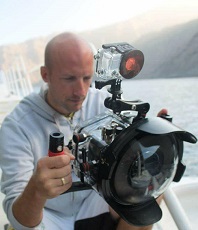
Christian Kemper is a TV journalist from Germany and freelance writer for three of the biggest diving magazines in Germany. He has been diving with and studying sharks for more than 20 years. The author has written two books about shark attacks and is about to publish his first English language book about sharks titled “The Fear Beneath.”
You can find his German Language book “Strange Pool Friends” on Amazon and at tredition.
He has also written several articles about sharks.
